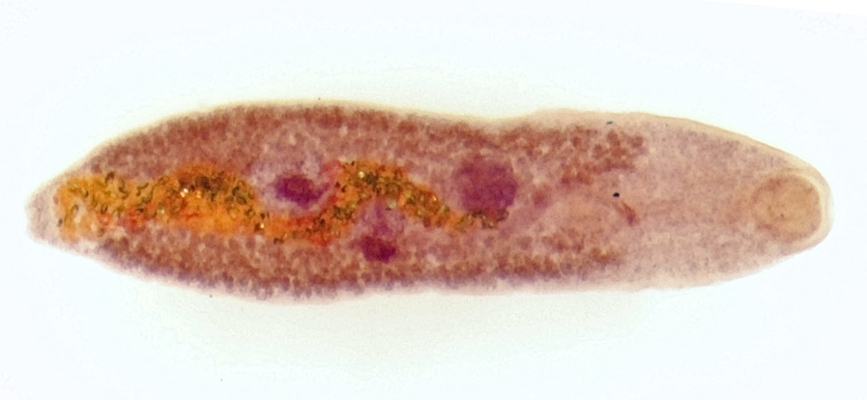Recent Research
Parasitology Division Personnel Contribute to Study of NTD Schistosomiasis Elimination Program in the Caribbean Region
The Neglected Tropical Disease (NTD) of human schistosomiasis caused by the trematode Schistosoma mansoni used to be common on several Caribbean Island, including Antigua, Montserrat, St. Lucia, Puerto Rico, St. Kitts and Nevis. Parasitology Division personnel, Dr. Martina Laidemitt and Dr. Eric Loker, have been involved in working with the Pan American Health Organization and World Health Organization to survey Antigua, Montserrat and more recently St. Lucia for evidence of the continuing presence of the obligatory freshwater snail vectors for S. mansoni, and whether snail populations might exist where S. mansoni infections might still be found. Expertise in differentiating among the various species of freshwater snails potentially contributing to the vector role is key to this enterprise. Some of their work has been published in The American Journal of Tropical Medicine and Hygiene https://doi.org/10.4269/ajtmh.20-0588 and https://www.ajtmh.org/view/journals/tpmd/109/4/article-p811.xml
Second edition of the textbook Parasitology: A Conceptual Approach Recently Published
Parasitology: A Conceptual Approach authored by Division Curator Eric Loker along with long-term UNM colleague Dr. Bruce V. Hofkin has just been released by CRC Press with a publication date of 2023. The book is one of the few textbooks on this subject material to take a “concepts first” approach to the discipline, and also in several passages espouses the value of museums and natural history collections of parasites in improving our understanding of our changing world. The long-term perspective museum collections of parasites can provide will help us gauge and mitigate the impacts of global phenomena such as climate change and exotic species introductions.
A pathogenic parasite of dogs pays an unexpected visit to Moab
An abrupt and unexpected outbreak of an initially mysterious illness in dogs in Moab in 2018 attracted the interests of the MSB’s Parasitology Division. Local veterinarians were quick to establish the illness was due to infection with a worm, Heterobilharzia americana, hitherto known from southeastern regions of the U.S. Further investigation of the outbreak by MSB biologists identified a pond within the city limits that harbored, living along its muddy banks, a small, inconspicuous species of snail, Galba humilus, found to be naturally infected with the larval stages of H. americana. Free-swimming larvae called cercariae emitted by infected snails were penetrating the skin of local dogs and initiating infections, some of which proved lethal. This outbreak of H. americana was remarkable because it occurred further north than normal and involved a different species of snail vector than the one normally implicated (Galba cubensis) in more southernly states. Read more about this, including factors that likely lead to the outbreak and the significance of this parasite acquiring a new snail host with respect to the potential for further range expansions. We are currently working with New Mexico State University on the potential of H. americana in the Rio Grande River Basin. These collections all end up in our collection regardless if they are the target host or parasite. See 10.1016/j.onehlt.2021.100280 and https://meridian.allenpress.com/journal-of-parasitology/article/109/6/633/497896
Ongoing research and collaboration in South America amplify what we know about schistosome diversity and epidemiology
The continent of South America is vast and diverse both in habitat and organisms. Unlike North America and much of Europe, very little was known about the distribution, hosts, and species diversity of schistosomes in avian hosts and the role in Cercarial Dermatitis. The schistosomes in birds are most notorious for causing Cercarial Dermatitis, or Swimmer’s Itch, and allergic reaction to the penetration of larval schistosomes on the skin. The schistosome species found in South America are diverse in gastropod hosts, which includes a genus, Chilia, found only in the southern half of the continent, can be found in iconic endemic hosts such as the black-necked swan, have close relatives either in North America, Northern Hemisphere, or Southern Hemisphere or global depending on the genus, and the very first record of a nasal dwelling schistosome in a bird outside of Eastern Hemisphere was found in Argentina in black-necked swans. Marine and freshwater schistosomes were recovered and described, along with links to life cycles in Argentina.
Population genetics of an endemic North American snail, now globally invasive, highlight how genetic diversity of the host and its parasites are shaped by time and geography
Physa acuta is a globally invasive freshwater snail native to North America. Prior studies have led to conflicting views of how P. acuta populations are connected and genetic diversity is partitioned globally. This study included a wider geographic sampling of P. acuta within its native range that provides insight into phylogeographic and population genetic structure, range-wide genetic diversity and estimation of the invasion history. Meta-analysis of P. acuta – trematode surveys globally is consistent with the ‘Enemy-Release hypothesis’. Additionally, in the host snails, genetic diversity, a proxy for population size, may play an essential role in how parasite communities are formed in invasive host populations of hosts. Research such as this provide the groundwork to modeling host-parasite invasion dynamics over time. See paper.
Select parasite research resulting from avian hosts donated by the MSB Division of Birds
Many vertebrates are difficult to collect because of very strict permitting rules. This MSB Parasites has teamed up with MSB Birds to examine mostly aquatic birds that are not easy to obtain as well as tapped into a large frozen collection of great horned owls. For example, see this collaborative paper on the parasites of a brown and blue-footed booby that were found stranded here in New Mexico. Current projects include a large time and space scale survey of the helminths great horned owls (Bubo virginianus), helminths of wintering New Mexico population of sandhill cranes, with a focus on Orchipedum in the trachea, and helminths of waterfowl and mammals collected for an ongoing PFAS study.



